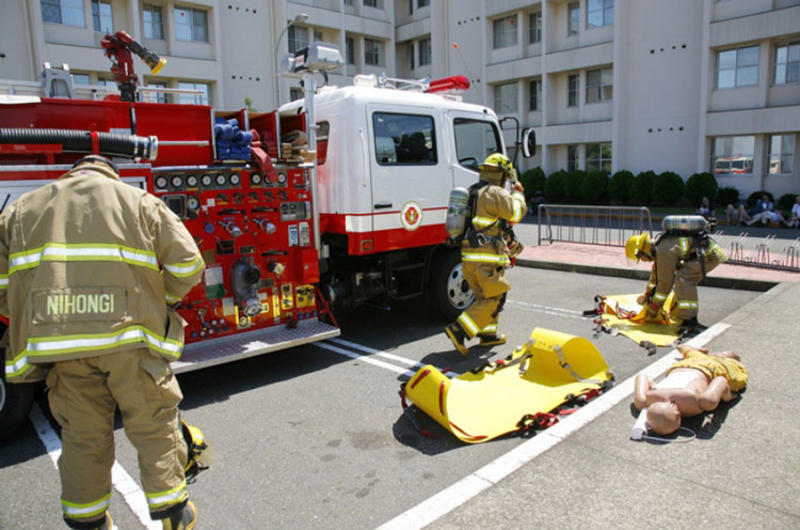

This website was created and maintained from May 2020 to May 2021 to commemorate the 75th anniversary of Stars and Stripes operations in the Pacific.
It will no longer be updated, but we encourage you to explore the site and view content we felt best illustrated Stars and Stripes' continued support of the Pacific theater since 1945.
Yokosuka makes changes after learning lesson from last year's quake

Emergency personnel respond to a simulated casualty during an earthquake drill at Yokosuka Naval Base in September. Base officials say they have upgraded their communications and bolstered other disaster policies since the March 11, 2011 earthquake struck Japan.
By ERIK SLAVIN | Stars and Stripes March 9, 2012
YOKOSUKA NAVAL BASE, Japan — When the shaking began on the ninth floor of Sakura Tower at 2:46 p.m. on March 11, 2011, Melissa Lindfors wasn’t sure if it was the sort of thing her family would just have to get used to at their new duty station in Japan.
She soon realized that the earthquake was much more than a common tremor.
Her two children ran toward the elevator car, which was clanking against its shaft. She gathered them, ushered them down the stairs and out the door, where she and others were greeted by the blaring sirens of emergency vehicles.
As things seemingly calmed down, the vehicles left and Lindfors went back up the stairs, until another aftershock hit.
A voice from the speaker system inside the building told her to head for high ground, with little more explanation.
Around that time, a deadly tsunami was making landfall about 200 miles to the north. Lindfors and other spouses walked up “Weather Hill,” a high central point at Yokosuka Naval Base.
“At Weather Hill we were told by someone in uniform that we were overreacting and needed to go home, even though the warning said to go to the top point,” Lindfors recalled.
A six-foot tsunami warning was issued at Yokosuka that day, though the base ultimately escaped damage.
Lindfors was at least able to hear the warning from the speaker in her base apartment building. On Weather Hill, those same warnings sounded garbled. Others on base could not hear the outdoor speakers known the “giant voice,” as they attempted to broadcast information in the midst of overloaded phone lines and spotty Internet service.
In the days following the earthquake, and as the situation at the Fukushima Dai-ichi nuclear power plant grew more dire, unfounded rumors on base competed with command information, news outlets, and other sources of information — and at times, it seemed the rumors rang loudest.
Yokosuka Naval Base officials say that they have taken the lessons learned from that rumor-filled environment and made a host of changes, both in the way they prepare for disasters and in their capabilities to keep people informed.
“We’ve done a 180 on [communications], to get information to people in a fast and appropriate way,” said Jeff Lindaman, the base’s emergency management officer, who took over a few months after last year’s disaster.
Through a newly acquired alert system, the base is now capable of sending text messages to registered smartphones, email accounts, Twitter accounts and other information services, Lindaman said. The messaging system is designed for fast updates on typhoons, earthquakes and other natural disasters, he said.
The much-maligned giant voice should also perform far better during future crises.
The speaker system was installed as a prerequisite for having a nuclear carrier on base, spokeswoman Michelle Stewart said.
“It really wasn’t there to provide a warning to everyone on the base for earthquake or tsunami,” Stewart said. “Because of March 11, command looked at that system and determined the need to able to do more. We got the funding to do additional things to that system to make it more audible.”
The giant voice upgrade should be complete in the next month or so as workers install more speakers, Lindaman said. It will be tested on the last Friday of every month.


